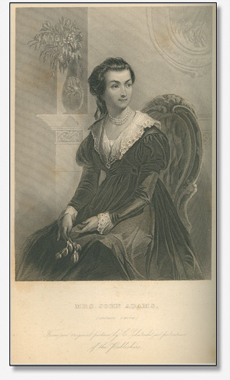
Rufus W. Griswold, The Republican Court, or, American Society in the Days of Washington. New and rev. ed. (New York, 1856), plate opposite 169. First ed., 1855.
ABIGAIL SMITH ADAMS (1744-1818) One of the most well-known women in American history, Abigail Adams famously wrote to her husband, John Adams (1735-1826), asking him to “Remember the ladies, and be more generous and favourable to them than your ancestors. Do not put such unlimited power into the hands of the Husbands.” (March 31, 1776). In her letters to her husband, Abigail frequently wrote in favor of women’s rights as well as of racial equality. Her other correspondents included writer Mercy Otis Warren. In 1789 Adams became vice president to George Washington, which brought Abigail and their two children, John Quincy and Abigail, to New York, then the capital. Every Monday, Abigail would receive guests at her home in Richmond Hill, just northwest of the city. She describes her social life in a letter to her sister thus: “Gentlemen and Ladies, as many as inclination, curiosity or Fashion tempts come out to make their Bow & Curtzy, take coffee & Tea, chat a half hour, or longer, and then return to Town again.” She continues, “On Tuesday the same Ceremony is performed at Lady Temple’s, on Wednesday at Mrs. Knox’s, on Thursdays at Mrs. Jay’s, and on Fryday at Mrs. Washington’s, so that if any person has so little to employ themselves in as to want an amusement five Evenings in a week, they may find it at one or other of these places. To Mrs. Washington’s I usually go as often as once a fortnight, and to the others occasionally.” In 1790, the capital moved to Philadelphia, introducing Abigail to a new city. She speaks early on of a place filled with parties, balls, and amusements “equal to any European city.” During her husband’s terms as vice president and president, from 1789 to 1801, she traveled back and forth from Philadelphia to their family home in Braintree. By the time Adams became president in 1797, Abigail had begun to express discontentment with Philadelphia society, seeming at times nostalgic for New England. She wrote to her sister on March 5, 1798, “There is sociality enough here amongst some of them. I always however sit it down when I meet with it, that N. England comes in for some share of it…Two nations are not more different than the N. Englanders and many Natives of this city. I must not however be too local.” In one letter, Abigail voices her complaints about a lack of politeness in the city, particularly toward her husband as president. She showed continuous support of his often controversial politics, and many critics lamented the supposed influence that she had over her husband. The Adams family moved from Philadelphia to Washington in 1800 when the federal capital relocated, and Adams finished out his career in government. After his loss to Jefferson in the Election of 1800, Adams and his family returned home to Massachusetts. In 1818, Abigail Adams died, seven years before her son John Quincy Adams would become the sixth president of the United States. Written by Emily Toner; edited by Annie Turner.
|

